Vita Sackville-West
Chasing the Moths
I did not approach her directly. She gently stole into my consciousness through The Letters of Vita Sackville-West to Virginia Woolf. I was particularly charmed by the thought of Vita and Virginia having tea together in the basement of 52 Tavistock Square, a large room used by the Hogarth Press as a stockroom. There Virginia would sit in an old armchair writing her masterpieces. The thought of them eating bun loaf surrounded by piles of books fascinated me. Virginia soon eclipsed Vita in my affections (I know exactly what she meant when she said of Vita, ‘She writes with a pen of brass.’) 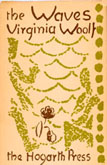 It is the lightness and quicksilver brilliance of Virginia’s language that, for me, sets her above all others. Its multi-faceted transparency floats off the page and its luminescence fires my imagination on all cylinders. She captures the elusive quality of life as it really is.
It is the lightness and quicksilver brilliance of Virginia’s language that, for me, sets her above all others. Its multi-faceted transparency floats off the page and its luminescence fires my imagination on all cylinders. She captures the elusive quality of life as it really is.
That Virginia published her own books at the Hogarth Press is one of the main delights of collecting her works. Unlike other literary figures whose publishers were quite separate from their lives and art, she and the press were in the same house. The business of the press was part of her everyday life and the effect this must have had on her writings should not be underestimated. Unlike more commercial rivals, the Hogarth Press never produced books in enormous numbers. This makes its modest little volumes all the more precious – especially when you consider that the book you are holding has occupied the basement room in Tavistock Square, has been in Virginia’s presence, has been a silent witness to Vita and Virginia’s tea time conversation. Pausing from her writing to help with an order, she may have picked that very book from the pile and tied it in a parcel. The intimacy between writer and book is undeniably exciting. Books were Virginia Woolf’s passion. Of the many debatable aspects of her life, this love of the printed page is an indisputably solid fact. In the essay ‘Street Haunting’, written in 1930 and later published in The Death of the Moth, is the following wonderful passage:
But here, none too soon, are the second-hand bookshops. Here we find anchorage in these thwarting currents of being; here we balance ourselves after the splendours and miseries of the streets. The very sight of the bookseller’s wife with her foot on the fender, sitting beside a good coal fire, screened from the door, is sobering and cheerful. Books are everywhere; and always the same sense of adventure fills us. Second-hand books are wild books, homeless books, they have come together in vast flocks of variegated feather, and have a charm which the domesticated volumes of the library lack.
When I first read these lines twelve years ago, I immediately felt a kinship with Virginia; this common interest in old books and secondhand bookshops provided a key with which to unlock a box of literary delights.
The lid of that treasure chest had been tantalizingly opened, just enough to catch a glimpse of the riches within, by the excellent television adaptation of Nigel Nicolson’s Portrait of a Marriage, a book which deals with the affair between Vita Sackville-West and Violet Trefusis. Inspired and intrigued, I set out to acquire a modest fifteen books by or about Vita and Virginia, a target soon passed and since exceeded many times over. I distinctly remember reaching the milepost of one hundred books. Strange how important the amount seemed at the time; nowadays the number of books I own is an irrelevance. There may well be some profound truth in this change of perspective, but I can’t quite put my finger on what that truth might be. Had I known the blood, sweat and tears this labour of love would cost, and there have indeed been copious amounts of all three, would I have begun? The answer must be yes. It has been a journey well worth the making, one that I would gladly repeat.
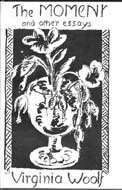 The Moment and Other Essays, The Hogarth Press, December 1947. 10,000 copies printed.
The Moment and Other Essays, The Hogarth Press, December 1947. 10,000 copies printed.
My collection of Virginia Woolf began modestly with some later impressions of her works. I can still remember the thrill of finding first editions of The Moment and The Captain’s Death Bed in the backwaters of my beloved County Durham, caressing them on the bus back to Newcastle, feeling the satisfyingly age-worn boards and looking at the wolf’s head colophon on the title page. I could hardly wait to show these little treasures to my dad when I got home. My dad has always encouraged me to appreciate and value good books; being an artist, he loves books for their aesthetic qualities, the paper, the printing, how a book feels in your hands. All of this I have inherited from him. We also think along the same lines about first editions, that although firsts are obviously very nice, later editions have equal merit. The same being true for dust wrappers – though desirable, we would both rather have a book in fine condition without a wrapper than one with a wrapper that is almost falling to pieces. These opinions are not fashionable, but I make no apology for holding them.
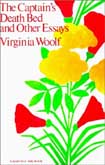 The Captain’s Death Bed and Other Essays, The Hogarth Press, May 1950. 10,000 copies printed of which 2000 were issued as the Uniform Edition.
The Captain’s Death Bed and Other Essays, The Hogarth Press, May 1950. 10,000 copies printed of which 2000 were issued as the Uniform Edition.
My own style of book collecting is unashamedly ‘old school’. I don’t altogether approve of the new breed of dealer that has emerged in the last few years. Thankfully there are still a good number of ‘old school’ dealers around, from whom buying books is a privilege and a delight. Their depth of knowledge is based upon experience rather than being heavily dependent upon the internet. They love books as I do, for their character and beauty rather than for their monetary value. They can and will discuss art and literature at length. The relationship between dealer and collector is vitally important, for the selling of books is a finely balanced art that should not be regarded as a purely commercial venture.
Buying books mail order, let alone via the internet, has never interested me. In her essay ‘Street Haunting’, Virginia goes wandering the streets of London on the pretext of buying a lead pencil. So it is for me with secondhand books. What better excuse to go off wandering by foot, by bus and by train, the dusty streets, the quiet lanes, the forgotten corners of northern England? Those secret places with their melancholy air of dereliction, whose well-worn charm matches so well the books I covet, to travel in the midst of such faded splendour is one of life’s subtle and sublime pleasures.
Even after many years and many disappointments, I still travel hopefully. All is possible, my excited heart tells me as I journey toward another shop, a little shop under the shadow of Roseberry Topping perhaps. It is a Thursday afternoon. As I walk from the bus depot, past the fire station, down a back lane and into the main street, my pulse quickens, the hunt is on, the thrill of the chase has me in its grip. I open the door and step inside. The lady at the counter is knitting as usual. All my old friends are there, those books my eye has glanced over time and time again, waiting patiently on the shelves for someone to give them a good home. But wait, my eye is drawn to a small book bound in cinnamon cloth. The Hogarth Press. As always, my heart skips a beat as I see those words at the foot of the spine. Lifting the book down I find that I’m holding a copy of A Room of One’s Own. I look at the title page: Published by Leonard and Virginia Woolf at The Hogarth Press, 52 Tavistock Square, London W.C. 1929. Turning the page I wonder which impression it will be. The only words on the next page are the printer’s name, R. & R. Clark of Edinburgh. My mind registers First Edition – First Impression! After a little haggling the lady has to put down her knitting and phone the shop’s owner. The book is mine for thirty pounds. The Cleveland Hills shone like jewels that afternoon as I rode away from Stokesley on an elderly Tees & District double-decker; and the brightest jewel of all was the little book in cinnamon cloth that I took out of a crumpled brown paper bag and held in my trembling hand.
Every one of my books has a similar story to tell; a journey, a place, a person. Lifting down a book from my shelves triggers the rusty levers in my mind and suddenly I’m in Lancashire or Northumberland; I’m drinking Dutch coffee from a chipped enamel cup in Bridlington; I’m helping to stack bookshelves in a dusty basement in Berwick; I’m standing on Oxenholme station soaked to the skin, after being caught in a downpour at Kendal; I’m sitting on a bus approaching Saltburn, with all the promise of the bookshops I would visit that day before me, thinking I’d be a very happy man if life could always be so. Such are the unexpected moments of intense pleasure when something seemingly trivial reveals some greater truth, those rare glimpses that Virginia describes so well and which greatly influenced her writing style.
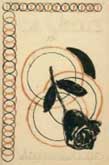 The Years, The Hogarth Press, March 1937. 23,142 copies printed of which 5000 were issued as later editions.
The Years, The Hogarth Press, March 1937. 23,142 copies printed of which 5000 were issued as later editions.
The good fortune I have experienced in collecting Virginia’s work never ceases to amaze me. I am not a particularly spiritual person, but I sometimes feel as if I’m being guided toward them, that someone wishes me to find these little books. Indeed, last year I found myself in the Oxfam bookshop in Durham, where I stumbled across a uniform edition, in a pale green wrapper, of The Common Reader from 1945. As I checked the book’s condition I distinctly felt a hand upon my right shoulder. Turning around to see who was behind me, I found myself alone in that little back room. Perhaps it was nothing, a trick of the brain, but I can’t quite forget that moment, a moment that was at once disjointed yet complete, disquieting yet calm. Perhaps I am becoming too fanciful, but the reader will, I’m sure, indulge me if I wonder who this benevolent spirit might have been. By choice it would be Stella Duckworth. Stella was the half sister of Virginia and Vanessa by their mother’s first marriage; the three bore a strong resemblance to one another, the fine classical features, the large heavy-lidded eyes, the long graceful necks. But for me, Stella was the greater beauty. In ‘A Sketch of the Past’, a long autobiographical essay to be found in Moments of Being (1976) Virginia gives a moving description of Stella:
Her charm was great; it came partly from this modesty, from this honesty, from this perfectly simple unostentatious unselfishness, it came too from her lack of pose, her lack of snobbery; and from the genuineness, from something that was – could I put my finger on it – perfectly herself, individual. She reminded me always of those large white flowers – elder-blossom, cow parsley, that one sees in the fields in June. Or again, a white faint moon in a blue sky suggests her. Or those large white roses that have many petals and are semi-transparent. She remains quite distinct in my mind. What is odd is that I cannot compare her either in character or face with anyone else, I have never seen anyone who reminded me of her.
Stella died shortly after her marriage, at the age of twenty-eight. Her tragically short life, the shadowy glimpses we get of her through Virginia’s early writing and memoirs, the haunting image we see in photographs, all of this adds to her enigma. The reader may be becoming weary of my romantic notions, so let us reluctantly return to the present and more practical matters. Perhaps the luck I experience in finding these books is not due to spiritual intervention but is merely the familiarity I have with their appearance. It may well be that having seen so many Virginia Woolf books, I have engrained upon my subconscious their exact shape and colour, how the jade green of the boards fades to the mellow patina of old copper, the shape of the words ‘The Hogarth Press’ on the spine. My memory has retained every detail. My eyesight is not of the best, the lighting in bookshops and at book fairs is often less than ideal, and the Hogarth Press used rather small type; could it be that my mind uses this blueprint to enable me to find these little treasures so surely and quickly ?
 A Letter to a Young Poet, The Hogarth Letters No. 8, The Hogarth Press, June 1932. 6000 copies printed of which 500 were bound up in the collected edition of The Hogarth Letters.
A Letter to a Young Poet, The Hogarth Letters No. 8, The Hogarth Press, June 1932. 6000 copies printed of which 500 were bound up in the collected edition of The Hogarth Letters.
Most people regard Virginia Woolf primarily as a novelist, but it is the essays that have given me the greatest pleasure, both the cerebral joy of reading such brilliant criticism and the physical satisfaction of collecting the books themselves. The three volumes previously mentioned, The Death of the Moth, The Moment and The Captain’s Death Bed are my particular favourites. I remember buying lovely copies of two of these in North Yorkshire. The dealer in question, a shrewd man who had begun his career selling fruit and vegetables in the wilds of Northumberland, told me that he had recently acquired a collection of literature including some Virginia Woolf. Unfortunately these were not at the shop, so I had to repeat the long bus journey from Newcastle to Richmond via Darlington a couple of days later. The most expensive item was a first edition of The Captain’s Death Bed, in mint condition, with an equally pristine wrapper. Even though I already owned a fine copy and the canny bookseller refused to haggle, the yellow and black Vanessa Bell painting on the cover was too seductive to refuse. Also irresistible was a fifth impression of The Death of the Moth, from March 1947, again sporting a beautiful Vanessa Bell wrapper over its bright blue boards.
The Seventies produced a plethora of books about Virginia: the Quentin Bell biography, the diaries, the letters and a multitude of other fascinating and informative volumes were published in that decade. I first caught sight of many of these books at the unlikely venue of North Shields public library. Over the next few years I came to realise just what elusive creatures some of them are. It has been in the fair Ridings of Yorkshire that I have tracked most of them down. Yorkshire has always been a happy hunting ground for me, its shops and fairs yielding far more trophies than my native Tyneside. I recall seeing a full set of the eleven volumes of diaries and letters in a locked room above Jack Duncan Books in York; the memory of those books and the disappointment at being unable to afford them haunted me for years. Much later I bought my first set of the five volumes of diaries not fifty yards from that room; attending the Harrogate book fair later the same week, I was lucky enough to find, in similarly excellent condition, the six volumes of letters. How proud I was to see them lined up along my shelf. Coincidentally, I have recently repeated this fortuitous fluke in Edinburgh, buying the diaries at a shop on the Wednesday and the letters at a fair the following Saturday. The decadent indulgence of owning two complete sets – they stand one above the other on my shelves – more than makes up for those years of longing.
 Granite and Rainbow, The Hogarth Press, June 1958. 6000 copies printed.
Granite and Rainbow, The Hogarth Press, June 1958. 6000 copies printed.
No article on collecting Virginia Woolf would be complete without paying homage to the gospel according to B.J. Kirkpatrick. Her bibliography is not only definitive, it is the supreme example of the bibliographer’s art, an informative masterpiece that no serious collector could be without. In the process of researching and later revising her book, Miss Kirkpatrick discovered many essays and reviews not previously published in book form; Leonard Woolf later published these as Granite & Rainbow (1958) and Books & Portraits (1977). It took me years to find a copy of Granite & Rainbow, a notably elusive and highly rated item. I finally tracked one down at the York book fair earlier this year, buying it from Adrian Harrington for about half what I had expected to pay. That January fair in York turned out to be very fruitful; my windfalls also including the English first of the previously mentioned Books & Portraits and two beautiful Hogarth Press pamphlets, Walter Sickert:A Conversation (1934) and Reviewing (1939), both penned by Virginia.
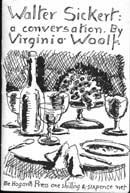 Walter Sickert: A Conversation, The Hogarth Press, October 1934. 3800 copies printed.
Walter Sickert: A Conversation, The Hogarth Press, October 1934. 3800 copies printed.
Mention must be made of the Virginia Woolf Society of Great Britain which I joined in May 1999, shortly after its formation. I would heartily encourage anyone with an interest to become a member, if for no other reason than to receive their excellent Bulletin, published three times a year, containing a lively mixture of articles, reviews and letters about Virginia and the Bloomsbury scene. It is a society that I am very proud to be associated with. That they are dedicated to keeping Virginia’s name alive in the country of her birth is a truly worthy cause; the noble act of restoring the overgrown graves of Virginia’s parents and that of the aforementioned Stella in Highgate Cemetery also touched my heart. My only criticism would be that few of the social events take place north of London. I can see the justification for this – after all, the significant places in Virginia’s life are in London and the south. Being unable to travel to these events I often feel slightly left out, with the Bulletin as my only connection. Surely there are others in the north of England and Scotland who are as passionate about Virginia Woolf as myself, who might enjoy meeting with like-minded people?
I have recently rediscovered the delights of Edinburgh. One Tuesday in late March I made my first foray across the border in almost twenty years. Some of the shops had gone, others had moved or changed their appearance, but the number and variety of bookshops was pleasantly surprising. Leaving the sun-filled street, I entered the atmospheric gloom of West Port Books. Two ladies sat talking; the first reminded me rather of a Vanessa Bell portrait; the second wore a striking red blouse with a double row of black buttons, her eyes sparkled as she sat nursing her cup of coffee. She seemed ill suited to stillness, a rare moth that would suddenly take flight and be gone for ever. I ask for anything by or about Virginia Woolf. Suddenly, the moth stirs and speaks. Between us fall sentence after sentence, pell mell, one chasing another: the comment in Three Guineas that Margaret Oliphant ‘smeared your mind and dejected your imagination’… Katherine Mansfield… Woolf didn’t like other writers invading her territory. Then, ‘Would you like to write an article for me?’ Jennie Renton introduced herself and the Scottish Book Collector, the deal was struck, the friendship forged.
 Three Guineas, The Hogarth Press, June 1938. 16,250 copies printed. Kirkpatrick notes that probably more than 8000 copies were issued as this first edition, the remainder being issued as the Uniform Edition.
Three Guineas, The Hogarth Press, June 1938. 16,250 copies printed. Kirkpatrick notes that probably more than 8000 copies were issued as this first edition, the remainder being issued as the Uniform Edition.
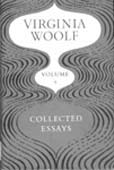 The Collected Essays of Virginia Woolf, published by the Hogarth Press. Volunes 1 and 2, October 1966, Volumes 3 and 4, February 1967, 5500 of each.
The Collected Essays of Virginia Woolf, published by the Hogarth Press. Volunes 1 and 2, October 1966, Volumes 3 and 4, February 1967, 5500 of each.
That afternoon I visited the private premises in St Bernards Row of John Updike Rare Books. Although I’ve been in many locked rooms filled with rare and valuable editions, the calibre of their stock took my breath away. Ian and Edward made me feel most welcome, even providing coffee and biscuits in the front room by the fire. I had never seen the four volumes of Collected Essays, earlier and much rarer than the volumes of diaries and letters, and they had two sets for sale. Later on, by strange coincidence, considering the conversation in West Port, I bought two copies of Three Guineas:at McFeely’s Bookstore, the first edition in its lemon yellow boards from June 1938, and at Till’s, the Uniform Edition in jade green boards and pale green wrapper from November 1943. They lie before me as I type, along with my Kirkpatrick, opened at page 106; once more I’m walking the streets of Edinburgh on that Tuesday.
Membership of the Virginia Woolf Society of Great Britain costs £10 pa. Details from Stuart N. Clarke, Fairhaven, Charnley’s Lane, Banks, Southport PR9 8HJ. Tel/fax:01903 764655
A Bibliography of Virginia Woolf by B.J. Kilpatrick and Stuart N. Clarke, Soho Bibliographies No. 9. Clarendon Press, Oxford. Fourth edition, 1997.
A Checklist of The Hogarth Press, 1917-1946 by J. Howard Woolmer. Woolmer/Brotherson Ltd. Revere, Pennsylvania, USA, 1986.
Professor Susan Sellers of St Andrews University and Dr Jane Goldman of Dundee University are General Editors of the fully explicated and annotated Cambridge University Press Edition of the writings of Virginia Woolf.
Copyright Frederick Lewis 2005.

Comments